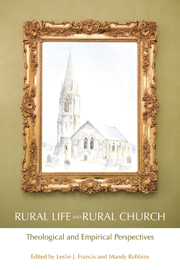Book contents
- Frontmatter
- Contents
- Preface
- Foreword by The Bishop of Shrewsbury, The Rt Revd Mark Rylands
- 1 Introduction: shaping rural theology
- PART 1 PERSPECTIVES FROM THE BIBLE
- PART 2 PERSPECTIVES FROM ORDINARY THEOLOGY
- PART 3 THEOLOGICAL AND SOCIOLOGICAL PERSPECTIVES
- PART 4 HISTORICAL PERSPECTIVES
- 11 Blackshawhead: a local case history in rural church categorization
- 12 Is the rural church different? The special case of confirmation
- 13 Rural Anglicanism: one face or many?
- 14 Pastoral fragments: discovered remnants of a rural past
- PART 5 LISTENING TO VISITORS
- PART 6 LISTENING TO THE COMMUNITY
- PART 7 LISTENING TO CHURCHGOERS
- PART 8 LISTENING TO CHURCH LEADERS
- PART 9 SATISFACTION AND STRESS IN MINISTRY
- Contributors
- Sources
- Subject Index
- Name Index
12 - Is the rural church different? The special case of confirmation
from PART 4 - HISTORICAL PERSPECTIVES
- Frontmatter
- Contents
- Preface
- Foreword by The Bishop of Shrewsbury, The Rt Revd Mark Rylands
- 1 Introduction: shaping rural theology
- PART 1 PERSPECTIVES FROM THE BIBLE
- PART 2 PERSPECTIVES FROM ORDINARY THEOLOGY
- PART 3 THEOLOGICAL AND SOCIOLOGICAL PERSPECTIVES
- PART 4 HISTORICAL PERSPECTIVES
- 11 Blackshawhead: a local case history in rural church categorization
- 12 Is the rural church different? The special case of confirmation
- 13 Rural Anglicanism: one face or many?
- 14 Pastoral fragments: discovered remnants of a rural past
- PART 5 LISTENING TO VISITORS
- PART 6 LISTENING TO THE COMMUNITY
- PART 7 LISTENING TO CHURCHGOERS
- PART 8 LISTENING TO CHURCH LEADERS
- PART 9 SATISFACTION AND STRESS IN MINISTRY
- Contributors
- Sources
- Subject Index
- Name Index
Summary
Abstract – The nationally published statistics of confirmation candidates in the Church of England between 1950 and 1999 are explored for three groups of dioceses. These groups are the most rural, the most urban and a group that lies around the centre of the continuum between rural and urban. The decline in the number of candidates after the 1960s is traced. The figures are also compared with the population of the dioceses, the members of the electoral roll and the numbers of Easter day communicants. The gender balance with confirmation candidates is also explored for this period. Attention is drawn to the differences between the urban and rural patterns of presentation of candidates for confirmation and the changes in these during the fifty year period being considered. A number of explanations for the differences noted are advanced and it is suggested that these possible explanations are best tested through research at diocesan level. Attention is also drawn to the weaknesses inherent in the rural/urban model when it is used as a descriptor of the Church of England.
Introduction
In her article ‘Is the rural Church different’, Roberts (2003) presented a careful assessment of the potential of the statistics published by the Church of England for enabling informed debate about the differences between different parts of the church. Roberts focused particularly on two dioceses as representative of the rural and urban church, Hereford and Birmingham respectively. The intention of this article is to build on the insights that Roberts presented by using a more detailed focus on the issue of confirmation across a broader spectrum of dioceses and a larger time frame.
- Type
- Chapter
- Information
- Rural Life and Rural ChurchTheological and Empirical Perspectives, pp. 131 - 144Publisher: Acumen PublishingPrint publication year: 2012



